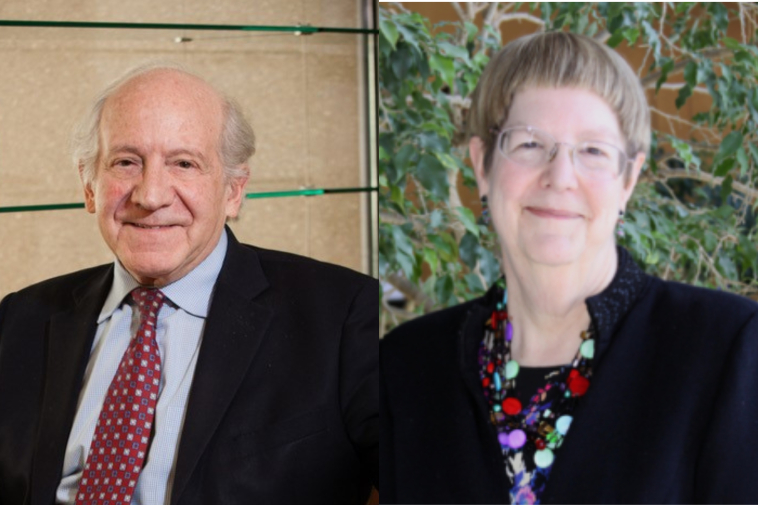Dr Jonathan Berek and Dr Joanna Cain on eradicating cervical cancer

Dr Jonathan Berek, Past Chair of the Committee on Women's Cancer, and Dr Joanna Cain, former associate Committee member, share their views on where we are and what comes next in our journey to end cervical cancer.
What is the state of cervical cancer around the world?
Joanna Cain: We can start with the fact that half a million women get cervical cancer every year and about half of them die, and the majority are in low-income countries. During Covid, it got worse because many of the vaccine and the screening programmes fell off. So right now, we are trying to get back on track, knowing that the World Health Organization (WHO) wants us to be at 90 percent of 14 year olds vaccinated by 2030. So we have a lot of work to do.
Jonathan Berek: It is a major problem everywhere, particularly in areas where there is a lack of resources. But even the United States, which is considered a developed country, still has a problem with cervical cancer, with well over 4,000 deaths per annum screening and vaccination rates are very low in and in many places in the country.
Joanna Cain: We can definitely do better everywhere. Regarding the implementation of vaccination programmes, the most important thing to consider is how to deal with misinformation campaigns. And to achieve this, we must get multiple sectors informed and engaged. School-based vaccination programmes are amongst the most successful, so we should encourage teachers to learn about this, be knowledgeable, and feel they can educate children and their parents. Certainly, departments of health, religious leaders, and community leaders should also be part of an implementation strategy from the very beginning.
Regarding vaccination: what are the main success stories?
Joanna Cain: Australia, which is one of the leading countries in the fight against cervical cancer, stands out because they did several things that are important in implementation. For example, they had a rapid reaction plan to combat misinformation on any side effects that came out in the media, and it has served them well. One of the best ways to be ahead of the game in the fight against misinformation is providing the public with credible sources even before they are exposed to fake facts.
Senegal’s vaccination programme of nine year olds is another great success story. They re-started in 2018, and it looks like they are going to have a very good outcome. They utilise the school-based strategy, which is a very strong strategy. Senegal also succeeded in bringing together multiple sectors to support the project - so the government supports the school system, the physicians, and the community. Support is definitely an important part of the puzzle, and it points out where we are. At that point in time, there was still a lack of availability of the HPV vaccine, so they could only focus on one cohort, the nine year olds, rather than everybody eligible. Making vaccines more available will increase our chances to eradicate cervical cancer worldwide.
Jonathan Berek: That is important to emphasise. We can be hopeful that with a single vaccine and more availability over time - especially if we can persuade public health officials, governments, religious groups, schools and other key actors - we will do a lot better in the future. There will be more hard, fast data over time, indicating the reduction in mortality and disease incidence of cancers associated with HPV.
How can we improve access to prevention, essential especially in countries where women have no access to cancer treatment?
Jonathan Berek: Vaccination programmes are important, but screening programmes are key to our prevention efforts. See and treat programs implemented in various places in Africa in particular are critical, as they result in the destruction of tissues that are pre-malignant and early malignancy so that lives have been saved. Those programmes, as they expand, have the potential for great impact.
Joanna Cain: The WHO has drawn out a full map of strategies based on vaccines, which is the most likely method over time to eradicate the disease. Remember, this is a disease, a cancer that we can eradicate, which is just phenomenal. Screening programmes enable us to catch those people for whom vaccination will not be a successful strategy, but they still need to be identified before the disease becomes invasive. Treatment for invasive disease remains a struggle in many countries because even the funds for simple vaccination are limited.
What actions is FIGO implementing to fight cervical cancer around the world?
Joanna Cain: FIGO has had a longstanding relationship with WHO and has members participating in living systematic reviews and on the screening and treatment to prevent cervical cancer group of WHO. Proposals and ideas are wonderful, but they have to be implemented to make a real difference. In this respect, FIGO was able to bring together key experts from around the world globe to examine how we can implement vaccine programmes for pregnancy, as well as for HPV. Their guidance has been published in the International Journal of Gynecology and Obstetrics (IJGO) so health professionals can use it to map out the whole process. FIGO members societies and their constituents have a crucial role to play to step up our collective efforts to end cervical cancer.
Jonathan Berek: FIGO has been a very strong partner with WHO and other organisations uniting to try to effect change and eliminate cervical cancer. It's admirable, and the goal of trying to do this in the next decade is fantastic. How close can we come to that? How can we achieve it? Well, there are many obstacles, but I prefer to remain relatively optimistic about it. I think we can improve substantially in the next decade or two and save many lives.
Selected on-demand content from FIGO World Congress 2023 will be available soon. Register your interest